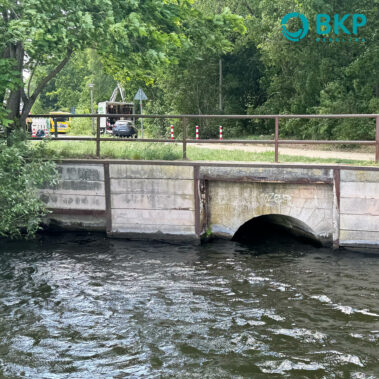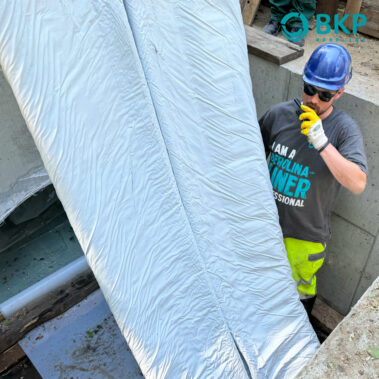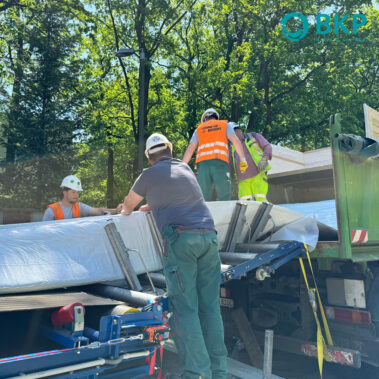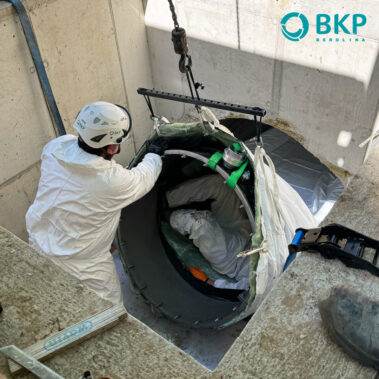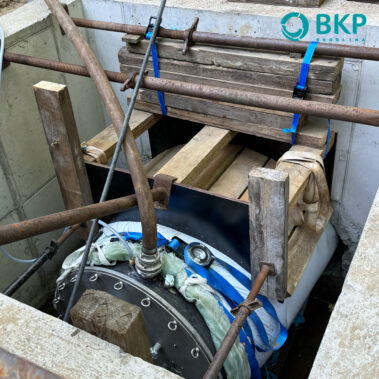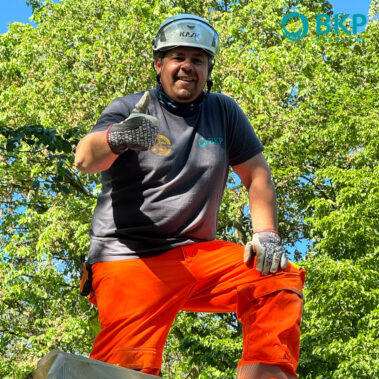“The Spree still flows through Berlin,” is the translation of a verse of a well-known song about the city. And a lot of rainwater still flows through the Spree, which is discharged through sewers. Stehmeyer + Bischoff Berlin GmbH renovated one of these sewers with a mouth profile and direct outlet into the capital’s water vein over a length of around 280 meters on behalf of Berliner Wasserbetriebe. The team at BKP Berolina Polyester GmbH & Co. KG supported its long-standing customers with the production of four 17 millimeter thick Berolina-HF-Liners, know-how in planning and the workforce of its application technicians.
The network of stormwater sewers in Berlin measures 3,324 kilometers. In Baumschulenstraße in the Treptow-Köpenick district, some of these kilometers from all directions come together in the form of smaller sewers and flow into a final section before the Spree – with a mouth profile and a diameter of 1,546 by 900 millimeters. Even before the BKP hose liners were installed, Stehmeyer + Bischoff built new manholes and manhole connections and carried out bed profiling of the pipe. The liners were intended to ensure improved statics and hydraulics of the sewer.
Bigger, thicker, heavier – liner records for Stehmeyer + Bischoff
Stehmeyer + Bischoff has been working in sewer rehabilitation for over twenty years and has the wealth of experience and technology for large projects. Around 280 meters of mouth profile renovation, circle equivalent DN 1,225, wall thicknesses of 17 millimeters and a total liner weight of over 35 tons challenged everyone involved beyond the norm. In order to avoid any unwanted surprises, the Berlin company’s construction managers prepared even more intensively for the project. Several on-site appointments and construction process discussions between Berliner Wasserbetriebe, Stehmeyer + Bischoff and BKP Berolina also resulted in very detailed planning on which the later installations were based.
BKP meets expectations
Berliner Wasserbetriebe was impressed by the preparations, the creation of a risk matrix and the diverse project experiences of its partners. After the extensive preparatory work by Stehmeyer + Bischoff, the heavy liners were easily pulled in using the BKP conveyor belt including a folding device. David Kijewski and Olaf Meier, BKP application engineers, helped the “SteBi” crew in handling such a large and heavy liner. “The team carried out the job with great routine within a very short period of time,” says David Kijewski.
Despite the large wall thickness of 17 millimeters, the Berolina-HF-Liners fit perfectly to the host pipe due to their excellent extension behaviour. A negative mold made specifically for the project ensured that the liners adapted to the profile before the pipe section beginnings. Overstretching was prevented. The curing of the four sections went smoothly.
Highly motivated team defies adversity
A lot was demanded from the Stehmeyer + Bischoff team in this project. “The employees gave their all, a few times into the night,” says Christian Moser, technical director at BKP. “The team’s commitment was outstanding, which, combined with the detailed preliminary planning, made this successful installation possible.”
A lot of patience was also required from the construction site employees when maneuvering. Although the construction site was in an area with no through traffic, many cyclists and pedestrians still squeezed through the dead end to get to the Plänterwald or to the ferry terminal that leads to the opposite side of the Spree. Buses from the Berliner Verkehrsgesellschaft (BVG) joined in every five minutes to turn around in a loop directly in front of the Spree. Vehicles had to be moved and processes changed again and again.
Playing with the weather
The weather forecasts were a crucial factor for the project. Even a small amount of rainfall in the area would have meant that a larger amount of water would accumulate on the construction site, which could endanger the construction process. The section to be rehabilitated catches a number of inflows from the entire surrounding area. In order to ensure occupational safety, several measuring devices were placed in sewer positions around two kilometers away. If the level there had risen disproportionately, warning messages would have been sent to employees’ mobile phones and to an alarm box placed on the job site. This would have resulted in the installation being aborted.
Far-reaching advantages of relining
The employees celebrated the completion of the liner installation with a small barbecue. For Stehmeyer + Bischoff, the project on Baumschulenstraße represents a milestone and whets the appetite for further installations with even more experience. The Berliner Wasserbetriebe were also very satisfied: “The construction work was carried out quickly and to a high quality. The Berolina-HF-Liners from BKP fit perfectly and the camera inspection went without any complaints. We are impressed by the handling of the liners, the technology and the great cooperation between the colleagues,” says construction manager Reiko Rose.
The trenchless renovation method resulted in several decisive advantages for the water supply company: compared to the open construction method, the work was carried out much faster and with less use of machinery, there was significantly less noise and pollution in a natural environment and the cost-benefit ratio also spoke clear for relining. The “understanding of sustainability” proclaimed by Berliner Wasserbetriebe finds its ideal counterpart in sewer renovation with UV light-curing GRP liners, the technology with the lowest CO2 emissions.






